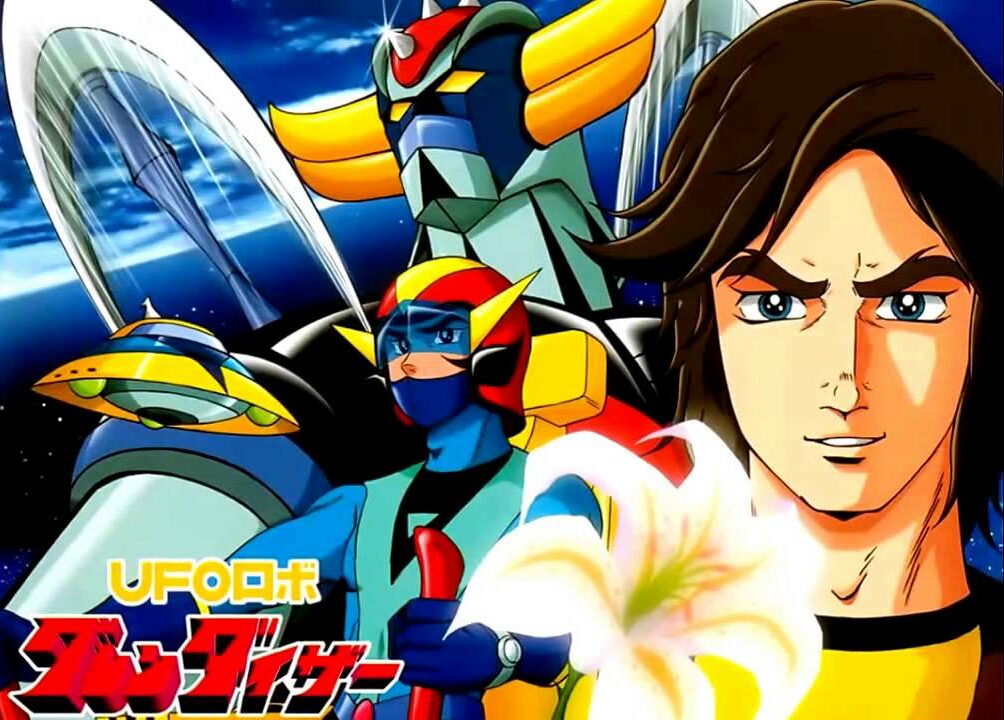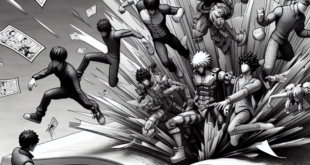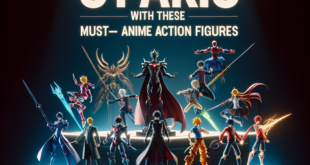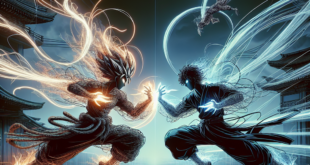Top Best 80s Robot Cartoons – Manga Anime

80s Robot Cartoons
1 / Daitan III
2 / Starzinger – 80s Robot Cartoons
Sci-Fi West Saga Toei Animation is responsible for producing the anime series Starzinger, also known as Esu Efu Saiyki Sutjing in Japan. In the United States, the series is titled Spaceketeers. It is a remake or adaption of Wu Cheng’en’s fantasy novel Journey to the West that is set in the science fiction genre. Yugo Serikawa was the one in charge of the film’s direction, while Leiji Matsumoto was the one who wrote the script. Between the dates of April 2, 1978 and August 24, 1979, it was broadcast on Fuji TV in Japan.
In the United States, it was published under the name Spaceketeers and was included in the Force Five series written by Jim Terry. On VHS releases made in the United Kingdom, the title was known to as Sci-Bots at the time. It was known as El Galáctico in Latin America at the time.
3 / Trider GT – 80s Robot Cartoons
Invincible Robo Trider G7 (also known as Muteki Robo Toraido J. Sebun) is a mecha anime television series that was produced by Sunrise in Japan and shown in Japan from the years 1980 to 1981. Additionally, it was known as “Trider G7,” “Unrivaled Robot Trider G7,” “Tryder G7,” “Bird Attack Tryder G7,” and “Tryder G7.”
The main character, Watta Takeo, is a sixth-grader who, throughout the course of the novel, must juggle his responsibilities as president of a firm, student life, and the conflict with an alien robotic empire. Even though it is at its core a Super Robot story, it presents a more realistic take on the genre than you might expect, such as needing to inform the local populace that the Trider G7 was being activated and having to take into account the financial costs of fighting.
4 / Mazinger Z – 80s Robot Cartoons
Go Nagai is the author and illustrator of the Japanese manga series Mazinger Z, also known as Majing Zetto and for a short time in the United States as Tranzor Z. Mazinger Z is about a super robot. After having its first run in Shueisha’s Weekly Shnen Jump between October 1972 and August 1973, the manga was then reprinted in Kodansha TV Magazine between October 1973 and September 1974. This was the first time the story was published in its entirety in Japan.
It was turned into an anime television series that was broadcast on Fuji TV during the months of December 1972 and September 1974. The second manga series, which was drawn by Gosaku Ota and was published at the same time as the television show, began airing practically simultaneously with the show and came to a finish around the same time as well. Great Mazinger, UFO Robot Grendizer, and Mazinkaiser are just some of the sequels and spin-off series that have come along as a result of the success of Mazinger Z.
Toei Animation’s Mazinger Z: Infinity is a theatrical film sequel that takes place ten years after the events of the Great Mazinger series. The film was released in theatres on January 13, 2018, and was animated by the studio.
The huge Mazinger Z is a super robot that was built with a fictitious metal known as Super-Alloy Z (Z, Chgokin Zetto). This metal was formed from a new element known as Japanium, which was extracted from a reservoir found only in the mud of Mt. Fuji in Japan. Professor Juzo Kabuto designed and constructed the mecha as a covert weapon to combat the evil that is depicted throughout the series as being embodied by the Mechanical Beasts of Dr. Hell.
This particular individual was a German member of a Japanese archaeological team that made the discovery of the remnants of a pre-Greek civilization called the Mycéne Empire on an island called Bardos. One of their discoveries was that the Mycenaean civilization had an army of steel titans that were approximately 20 metres tall.
After discovering underground prototypes of those titans that could be remotely controlled and coming to terms with the immense power they possessed in combat, Dr. Hell lost his mind and had all of the other scientists on his research team executed, with the exception of Professor Kabuto, who was able to flee. Professor Kabuto was the only one to survive.
The sole survivor travels back to Japan and makes an effort to warn the rest of the world about the impending threat. In the meantime, Dr. Hell sets up his headquarters on a movable island, establishes the new Underground Empire, and formulates a strategy to become the new ruler of the globe by employing the Mechanical Monsters.
Kabuto decides to build Mazinger Z as a defence mechanism against this, and he is successful in completing it immediately before he is killed by a bomb that was planted by Baron Ashura, who is a hybrid of a man and a woman. He is able to tell his grandson, Koji Kabuto, about the robot and how it should be used when he is on his deathbed. Koji assumes the role of the robot’s pilot, and from that point on, he fights not only the never-ending mechanical creatures but also the nefarious minions that Doctor Hell has dispatched.
5 / Jeeg Robot D ‘ Acciaaio
Steel Jeeg is a Japanese mecha anime series developed by manga creators Go Nagai and Tatsuya Yasuda. It was produced by Toei Doga (now known as Toei Animation) and directed by Masayuki Akehi. Steel Jeeg is also known as Kotetsu Jeeg or Koutetsu Jeeg. It was initially shown on NET in Japan from October 5, 1975, all the way through August 29, 1976, and it consisted of a total of 46 episodes. Steel Jeeg was also published as a manga in a number of children’s magazines, with the first instalment of the manga appearing in Kodansha’s TV Magazine in August 1975 and continuing until June 1976.
The show is the first instalment in Takara’s Magne-Robo Franchise, which eventually branched off into its own series after Dynamic Productions was given the rights to produce the show. Beginning on April 5, 2007, the Japanese satellite television network WOWOW began airing a sequel series titled Kotetsushin Jeeg.
Hiroshi Shiba, a young race car driver, has been critically injured and may not survive. His father, Professor Shiba, is a gifted scientist and archaeologist who is able to bring him back to life using a potent relic from the ancient and mysterious Jamatai Kingdom. This relic is a bronze bell that is secreted inside Hiroshi’s body and turns him into a kind of cyborg without his knowledge.
It is revealed that the bell is also the key to the reconquest of the Earth surface as the monarch of Jamatai, queen Himika, emerges from her hibernation in the subterranean. In their fruitless search for the relic, her goons kill Professor Shiba, but not before the scientist has just enough time to upload his thoughts onto a supercomputer located in a specially constructed defence base. Professor Shiba has also devised a gigantic fighting robot called Steel Jeeg, which is made up of magnetic limbs that can be interchanged and for which Hiroshi Shiba can serve as both the head and the conscience.
Professor Shiba has done this in preparation for the secret threat. His purpose is to defend modern Japan against the invaders, who are accompanied by other huge monsters with similar abilities (haniwa), as well as an army of subordinates. During these kind of conflicts, Jeeg receives assistance from a robot horse known as Panzeroid as well as a fighter aircraft that is able to fire replacement components and specialised weapons for his body.
The story of the series focuses on the progression of Hiroshi’s character as well as the efforts and subsequent failures of the underground society to return to power, which results in internal civil war.
6/ Astro Boy – 80s Robot Cartoons
Mighty Atom is the original name of the Japanese manga series Astro Boy, which was written and illustrated by Osamu Tezuka. In Japan, Astro Boy is better known by its original name, Mighty Atom.
Between the years 1952 and 1968, it ran as a serial in the magazine Kobunsha’s Shnen. The 112 individual chapters were compiled by Akita Shoten into a total of 23 tankbon volumes. In the year 2002, an English translation was released by Dark Horse Comics. Following the tragic passing of Umataro Tenma’s son Tobio, the main character of the novel is Astro Kid, a young boy built by Umataro Tenma out of an android with human feelings.
After some time, Hamegg buys Astro for his robot circus, but Professor Ochanomizu buys him back and frees him from his life of servitude. Ochanomizu adopts Astro and raises him as his own son, providing him with a robotic family and assisting him in leading a normal life similar to that of an average human child while also going on adventures with him. Astro eventually becomes Ochanomizu’s biological son.
Astro Boy has been adapted into three different anime series, each of which was produced by the first iteration of Mushi Production and its direct successor Tezuka Productions. Additionally, a fourth adaptation of Astro Boy is now in the works. The manga was first adapted for television as the popular animated series Astro Boy in Japan. It was the first show of its kind to embody the aesthetic that would go on to become synonymous with Japanese animation known as anime.
After finding success in other countries, the anime series Astro Boy was redone in the 1980s as New Mighty Atom, which is how the series was referred to in those nations, and again in 2003. He was given the position of Japan’s envoy for abroad safety in November of 2007.
On October 23, 2009, a computer-animated picture based in the United States on the original manga series created by Tezuka was released in theatres.
In March of 2015, a teaser for a brand-new animated television series was made available online. The popularity of the manga and anime series resulted in the creation of a huge media franchise that includes a number of films, including a major motion picture, as well as a library of video games and a number of soundtracks. The series was also among the first to adopt mass merchandise, such as action figures, collectible figurines, food products, clothes, stamps, and trading cards. This merchandise included action figures, collectible figurines, and food products. As of the year 2004, the franchise had generated $3 billion in revenue through the sale of items.
Tezuka’s most well-known work, the Astro Boy manga and anime series, has become one of the most successful franchises in the history of manga and animation in the world. It has been estimated that over 100 million copies of the manga have been sold around the globe, making it not just Tezuka’s best-selling manga but also one of the best-selling manga series of all time. The series is comprised of 23 tankobon volumes.
The anime series that debuted in 1963 was a huge success when it debuted on television in both Japan and the United States. The contribution that Astro Boy made to the growth of the anime and manga industries has received a lot of appreciation. It has been highlighted on a variety of best anime of all time lists and has served as motivation for a large number of other notable authors when it comes to the production of manga.
7/ Goldrake or Grandizer – 80s Robot Cartoons
Grandizer is the name of a Japanese Super Robot anime television series and manga that was developed by manga artist Go Nagai. In Japan, the series is called UFO Robot Grendizer, but in the United States, it is known as Grandizer. It is the third instalment in the Mazinger series, but it is not considered canon due to the fact that Mazinger Z: Infinity takes place roughly ten years after Great Mazinger. This eliminates any connection to the Mazinger anime storyline other than Koji Kabuto and Boss.
On the other hand, the Mazinger manga takes place in the same timeline as Mazinger Z and Great Mazinger, but there is a timeskip after Great Mazinger that is not specified. The anime television series was created by Toei Doga and Dynamic Planning. It ran on Fuji TV from October 5, 1975, all the way through February 27, 1977, and consisted of a total of 74 episodes. First seen in the United States as part of Mattel’s Shogun Warriors line of super robot toys, which were imported by the company in the late 1970s, and then in Jim Terry’s Force Five series, the robot was given the name Grandizer in both of these iterations of the franchise. It enjoyed widespread acclaim throughout several countries, including Italy, France, North Africa, France-speaking Canada (under the name “Goldorak”), and the Middle East (as “Goldrake”).
The extraction of Vegatron, a potent radioactive mineral, has led to the instability of the Vega homeworld. The cruel King Vega wants to expand his militaristic kingdom and locate a new planet to settle upon, so he unleashes his troops, which are made of flying saucers and enormous robotic creatures, and turns them first against neighbours like Fleed, which is a highly evolved but peaceful world. The formerly lush and picture-perfect Fleed has been transformed into a barren and radioactive wasteland.
After it is too late, the sole known survivor of the royal family, the Crown Prince Duke Fleed, manages to take the Grendizer from the Vegan invaders, who intend to use it to spearhead their invasion fleet. The Grendizer is a robotic manifestation of the Fleedian God of War. The Grendizer is a massive monster robot that communicates with Spacer (also known as Spaizer), a flying saucer that provides the robot with the ability to fly.
After escaping Vegan space by travelling at a speed greater than the speed of light, the Duke enters our solar system, changes his path to head toward Earth, and makes a hard landing in Japan on the slopes of Mount Fuji. In the neighbourhood of a modest ranch, he makes the acquaintance of a prominent scientist known as Doctor Umon, who is in charge of a research facility known as the Space Science Lab.
Kind-hearted Umon adopts the young humanoid alien and raises him as his own son, giving him the alias Daisuke. He also provides assistance to him in concealing Grendizer. Duke Fleed, who now goes by the name Daisuke Umon, is an employee at the ranch operated by Danbei Makiba (whose character is based on Abashiri Daemon from the manga Abashiri Ikka by Go Nagai).
8 / Voltes V – 80s Robot Cartoons
The Incredible Electromagnetic Machine The anime television series Voltes V (Hepburn: Chdenji Mashan Borutesu Faibu), more often known as simply Voltes V (pronounced as “Voltes Five”), is a production of Toei Company and was animated by Nippon Sunrise (formerly known as Soeisha). The Robot Romance Trilogy also consists of Chdenji Robo Combattler V and Tsh Daimos, and this book is the second in the series. Both Tadao Nagahama and Yoshiyuki Tomino are credited with producing and directing the work, respectively. Between the months of June 1977 and March 1978, it was broadcast on TV Asahi.
Since it first aired in the Philippines in 1978, Voltes V has developed into a significant cultural phenomenon there. Prior to that, the show had also garnered considerable attention in Indonesia and Cuba. A live-action television series adaptation of Voltes V: Legacy is now in production in the Philippines for airing on the GMA Network. The title of the show is Voltes V: Legacy.
One day, a vast horde of flying saucers from another world suddenly materialises from the depths of space and begin an invasion on the planet Earth. The simultaneous deployments of the invaders’ fleets of well-armed and highly mobile flying saucers devastate key strategic targets around the world and completely overwhelm the defenders, despite the best efforts of the militaries of the world and the Earth Defense Force under the command of Japanese Commander Oka. The invaders are hostile extraterrestrials hailing from the planet Boazan, which is ruled by an evil emperor.
They are commanded in battle by Prince Heinel, the emperor’s cruel nephew. The Boazanian commanders, sensing that their victory is almost certain, withdrew to Castle Heinel, a covert underground citadel built by their agents in preparation for their conquest, and ordered the massive bio-mechanical “Attack Beast Knight Dokugaga” to destroy humanity’s last remaining stronghold of resistance.
Mitsuyo Goh and Professor Hamaguchi, both Japanese scientists, have been working together Oka on a plan that was initially devised by Mitsuyo’s missing husband, Dr. Kentaro Goh, unbeknownst to the Boazanians. This plan was conceived by Mitsuyo’s husband before he mysteriously disappeared. It is revealed that all of their efforts up to this point were covertly meant to prepare the earth for this very eventuality. This is revealed after she forced her children Kenichi, Daijiro, and Hiyoshi to endure a gruelling training regimen alongside the American rodeo champion Ippei Mine and Megumi Oka, the daughter of Commander Oka.
The scientists take the children to a top-secret base on the hidden island of Ootorijima known as “Big Falcon.” There, they show to the five children the Super-Electromagnetic Robot, “Voltes V,” which was Kentaro Goh’s greatest life’s work and humanity’s last remaining hope for survival. Even though it takes them some time to get used to the controls, the five of them are able to cooperate and save the EDF from complete annihilation by defeating Dokugaga with their formidable Heaven Sword, also known as Tenkuu-ken.
9 / Future Robot Daltanious – 80s Robot Cartoons
An anime television series known as Future Robot Daltanious (, Mirai Robo Darutaniasu) debuted on Tokyo Channel 12 on March 21, 1979 and ran until March 5, 1980. The show ran for a total of 104 episodes. Toei Animation is responsible for its production, and Nippon Sunrise was a co-producer of the 47 episodes that make up the series.
In the year 1995, the planet Earth was subjugated by the Zaar Empire, which originated on the planet Akron in the Zaar solar system. After the destruction of every city on Earth, the few people who managed to survive now reside in makeshift towns and villages. Kento, an orphan left behind by the war, and his pals take refuge in a cave in order to avoid being captured by robbers. They uncover the hidden base of Doctor Earl, who is from the planet Helios, which was another planet that was conquered by the Zaar, inside the cave. Doctor Earl had taken the most significant technological accomplishment of the Helian race, the superrobot Atlas, with him when he had fled to Earth.
Atlas’s power is increased when used in conjunction with the intelligent lion robot Beralios. Daltanious is the name of the powerful robot that results from the combination of the various robots and the Helian fighter Gumper. Kento, a member of the Helian royal family and a descendant of Doctor Earl, is given the responsibility of leading the struggle to save Earth.
10 / Astro Robot – 80s Robot Cartoons
Top Best 80s Robot Cartoons – Manga Anime
Follow us for New Content Daily
Web – www.epicheroes.com
Twitter @epicheroes
Insta @epicheroesuk
http://www.youtube.com/c/Epicheroes
https://amazon.co.uk/shop/epicheroes
 Epic Heroes Entertainment Movies Toys TV Video Games News Art Pop culture news goodness
Epic Heroes Entertainment Movies Toys TV Video Games News Art Pop culture news goodness


